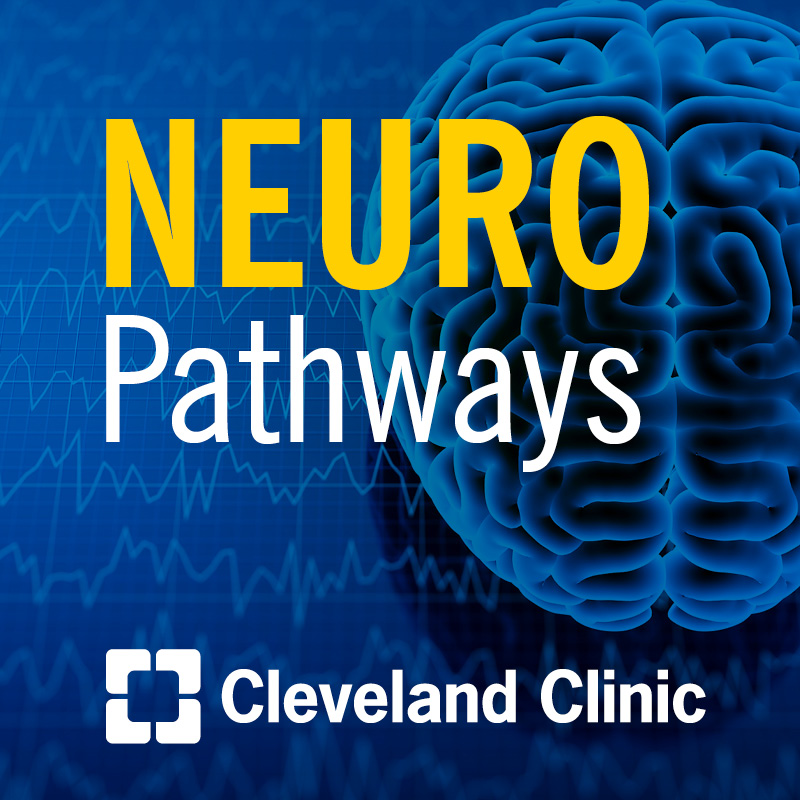Spinal Muscular Atrophy

Alexandra Bonner, MD, discusses spinal muscular atrophy, keys for diagnosis, and considerations for treatment.
Subscribe: Apple Podcasts | Podcast Addict | Spotify | Buzzsprout
Spinal Muscular Atrophy
Podcast Transcript
Neuro Pathways Podcast Series
Release Date: June 1, 2025
Expiration Date: May 31, 2026
Estimated Time of Completion: 30 minutes
Spinal Muscular Atrophy
Alexandra Bonner, MD
Description
Each podcast in the Neurological Institute series provides a brief, review of management strategies related to the topic.
Learning Objectives
- Review up to date and clinically pertinent topics related to neurological disease
- Discuss advances in the field of neurological diseases
- Describe options for the treatment and care of various neurological disease
Target Audience
Physicians and Advanced Practice providers in Family Practice, Internal Medicine & Subspecialties, Neurology, Nursing, Pediatrics, Psychology/Psychiatry, Radiology as well as Professors, Researchers, and Students.
ACCREDITATION
In support of improving patient care, Cleveland Clinic Center for Continuing Education is jointly accredited by the Accreditation Council for Continuing Medical Education (ACCME), the Accreditation Council for Pharmacy Education (ACPE), and the American Nurses Credentialing Center (ANCC), to provide continuing education for the healthcare team.
CREDIT DESIGNATION
- American Medical Association (AMA)
Cleveland Clinic Center for Continuing Education designates this enduring material for a maximum of 0.50 AMA PRA Category 1 Credits™. Physicians should claim only the credit commensurate with the extent of their participation in the activity.
Participants claiming CME credit from this activity may submit the credit hours to the American Osteopathic Association for Category 2 credit.
- American Nurses Credentialing Center (ANCC)
Cleveland Clinic Center for Continuing Education designates this enduring material for a maximum of 0.50 ANCC contact hours.
- Certificate of Participation
A certificate of participation will be provided to other health care professionals for requesting credits in accordance with their professional boards and/or associations.
- American Board of Surgery (ABS)
Successful completion of this CME activity enables the learner to earn credit toward the CME requirements of the American Board of Surgery’s Continuous Certification program. It is the CME activity provider's responsibility to submit learner completion information to ACCME for the purpose of granting ABS credit.
Credit will be reported within 30 days of claiming credit.
Podcast Series Director
Andreas Alexopoulos, MD, MPH
Epilepsy Center
Additional Planner/Reviewer
Cindy Willis, DNP
Faculty
Alexandra Bonner, MD
Center for General Neurology
Host
Glen Stevens, DO, PhD
Cleveland Clinic Brain Tumor and Neuro-Oncology Center
Agenda
Spinal Muscular Atrophy
Alexandra Bonner, MD
Disclosures
In accordance with the Standards for Integrity and Independence issued by the Accreditation Council for Continuing Medical Education (ACCME), The Cleveland Clinic Center for Continuing Education mitigates all relevant conflicts of interest to ensure CME activities are free of commercial bias.
The following faculty have indicated that they may have a relationship, which in the context of their presentation(s), could be perceived as a potential conflict of interest:
|
Glen Stevens, DO, PhD |
|
All other individuals have indicated no relationship which, in the context of their involvement, could be perceived as a potential conflict of interest.
CME Disclaimer
The information in this educational activity is provided for general medical education purposes only and is not meant to substitute for the independent medical judgment of a physician relative to diagnostic and treatment options of a specific patient's medical condition. The viewpoints expressed in this CME activity are those of the authors/faculty. They do not represent an endorsement by The Cleveland Clinic Foundation. In no event will The Cleveland Clinic Foundation be liable for any decision made or action taken in reliance upon the information provided through this CME activity.
HOW TO OBTAIN AMA PRA Category 1 Credits™, ANCC Contact Hours, OR CERTIFICATE OF PARTICIPATION:
Go to: Neuro Pathways Podcast June 1, 2025 to log into myCME and begin the activity evaluation and print your certificate If you need assistance, contact the CME office at myCME@ccf.org
Copyright © 2025 The Cleveland Clinic Foundation. All Rights Reserved.
Introduction: Neuro Pathways, a Cleveland Clinic podcast exploring the latest research discoveries and clinical advances in the fields of neurology, neurosurgery, neuro rehab, and psychiatry.
Glen Stevens, DO, PhD: Although thought of as uncommon, spinal muscular atrophy is the second most common severe hereditary disease of infancy and childhood after cystic fibrosis. Research estimates that spinal muscular atrophy affects between one in 6,000 to one in 11,000 live births, but with five subtypes, it is now understood to be a disease of varying age.
In today's episode, we're discussing spinal muscular atrophy, keys for diagnosis, and considerations for treatment. I'm your host, Glen Stevens, neurologist, neuro-oncologist in Cleveland Clinic's Neurological Institute. I'm very pleased to be joined by Dr. Alex Bonner. Dr. Bonner is a Cleveland Clinic pediatric neurologist fellowship trained in neuromuscular medicine. Alex, welcome to Neuro Pathways.
Alexandra Bonner, MD: Thank you.
Glen Stevens, DO, PhD: Alex, I think this is the first time we've met. Tell me a little bit about yourself and the audience, where you came from, why you do what you do, and what you do.
Alexandra Bonner, MD: Those are the fun questions. We can finish up there. I grew up in Northeast Ohio, so this is really home for me. I did my training and residency and fellowship here as well and have just such respect for my colleagues that I weaseled my way into sticking around. Actually, I fell in love with neuroscience in college. I took a brain and behavior class, became very interested in that basic science of how a nerve fires. Decided from there, I guess, I wanted to go to med school so I could be a neurologist and, of course, ended up back in the only field that still cares about the neuromuscular junction and nodes of Ranvier and all those basic science facts.
Glen Stevens, DO, PhD: Excellent. Excellent. Well, we're glad to have you. How long have you been at the clinic on staff?
Alexandra Bonner, MD: On staff, this is year number one, but I've been here for about seven years now.
Glen Stevens, DO, PhD: Okay. We're going to talk today particularly about spinal muscular atrophy. Tell us what spinal muscular atrophy is.
Alexandra Bonner, MD: Spinal muscular atrophy, it's a hereditary disorder that affects the anterior horn cells in the spinal cord. It's a progressive disorder. It leads to weakness and atrophy and ultimately it shortens the lifespan, but it does have a spectrum of phenotypes. Historically, those phenotypes have really been defined by the age of onset and the motor milestones that the kids achieved. But with spinal muscular atrophy, we've learned so much more about the genetics that our understanding of the condition has really changed.
Glen Stevens, DO, PhD: People out there sometimes listening and when they hear the word anterior horn cell, they start thinking about Lou Gehrig's disease. How is this different than Lou Gehrig's disease?
Alexandra Bonner, MD: There are hereditary causes of Lou Gehrig's disease that we're learning more about, but spinal muscular atrophy is really predominantly a condition of childhood. The predominance of even those patients often present in infancy. It is a progressive degeneration of just the lower motor neuron anterior horn cells, not the upper motor neuron that you see with Lou Gehrig's.
Glen Stevens, DO, PhD: Exactly. So someone has ALS or Lou Gehrig's disease and upper and a lower motor neuron and this is at the other end of the spectrum where you're just the lower motor neuron that's affected. What types of things do we see on physical exam in children that have spinal muscular atrophy?
Alexandra Bonner, MD: The most common spinal muscular atrophy that we will see is kids who present in infancy. What's going to first clue you in that something is wrong with this child is hypotonia, low tone that you see on exam. But of course low tone is very nonspecific, so then you're looking a bit closer. When you're examining the child, you'll see the low tone. It tends to be proximal lower extremity predominant. You'll see that there's a sparing of the facial and eye muscles. These infants are awake, alert, engaged, but have this low tone. When you check your reflexes, you'll see that those reflexes are absent or low. You can also pick up on some other clinical findings, so you might identify fasciculations of the tongue. Sometimes if it's a really early onset, you can see sequelae of lack of movement in the womb, so contractures, arthrogryposis, things like that.
Glen Stevens, DO, PhD: I'm glad you're able to say that word because I can never pronounce that word properly.
Alexandra Bonner, MD: Don't ask me to say it again.
Glen Stevens, DO, PhD: My understanding is maybe it's changed, but there's five subtypes.
Alexandra Bonner, MD: Yes, there are five subtypes.
Glen Stevens, DO, PhD: You want to go through those?
Alexandra Bonner, MD: Again, the five subtypes are historically defined by age of onset and motor milestone achieved, but now we have this layered information about the genetic underpinning that gives us a little more information. But of course the genetic information does not perfectly overlap with the phenotype of the subtypes, so I think it's most helpful to first talk about the subtypes as they were historically defined. Type zero is pretty uncommon, but that's the fetal onset. In utero, you'll see that there's less movement in utero, and these are the infants who often are born with contractures, arthrogryposis, and the sequelae of lack of movement.
Glen Stevens, DO, PhD: And life expectancy for the type zero, very short.
Alexandra Bonner, MD: Very short. Very short. The type one infants are often okay at birth but then quickly develop symptoms within the first few months of life. Those are the patients that you're really picking up with the low tone early on and some of the exam findings that we were describing previously. Type one infants are defined by the fact that they do not ultimately achieve sitting as a motor milestone. Infants and children with type two SMA, they have a little bit later onset of symptoms, often still in the infancy period. But what defines that category is the fact that they do achieve sitting as a motor milestone, but they do not go on to achieve walking. Infants and children with type three SMA, they ultimately achieve walking as a motor milestone. Type four, which is much less common, that's really the late onset SMA. We might have patients who you don't really see symptoms until well into adulthood and they might remain ambulatory through much of their lifetime.
Glen Stevens, DO, PhD: The other big issue is the breathing. Breathing affected more in zero, one, and two...
Alexandra Bonner, MD: Certainly.
Glen Stevens, DO, PhD: ... Less in three and four or...
Alexandra Bonner, MD: That is true. That is true. Really, everything is affected more in zero, one, and two to a greater degree and then a more rapid decline. That does include the respiratory muscles, but we still think about respiratory pulmonary function in type three and four patients with type three and four SMA as well.
Glen Stevens, DO, PhD: And life expectancy for three and four?
Alexandra Bonner, MD: Is much higher. Type four patients can live a pretty full life, but they'll notice that proximal lower extremity weakness and these patients can present looking more like a lower motor neuron predominant ALS picture. But there's that lack of upper motor neuron findings and some other clues that lead you away from an ALS diagnosis.
Glen Stevens, DO, PhD: We'll get to the genetic stuff in a bit, but I bring my child in to see you, maybe I'm concerned the head holding isn't... Tummy time, not getting the head up, those types of things. What do you see on the exam when you examine the child that has one of these forms of spinal muscular atrophy? I know you mentioned a little bit, but what are you checking specifically?
Alexandra Bonner, MD: Yeah, the first thing I really am looking for is just on observation. In an infant, they tend to have their limbs flexed, pulled up, pulled forward. There's sort of a movement about them. And when you're seeing low tone, especially of the proximal lower extremities, you tend to see the legs relatively extended, relatively abducted. That's classically called that frog leg positioning and that can really clue you into that proximal lower extremity hypotonia. When you're thinking about the breathing patterns, we often see the intrinsic respiratory muscles affected out of proportion to the diaphragm. When the patient tries to take a breath in, the diaphragm expands, pulls down, but the intrinsic muscles sort of collapse in. You can see this paradoxical breathing pattern.
Glen Stevens, DO, PhD: It's been a while since I've checked a reflex on an infant. I'm not sure how good you can get reflexes normally on an infant. I assume the reflexes aren't so good,
Alexandra Bonner, MD: Practice helps, but...
Glen Stevens, DO, PhD: I wouldn't know if I'm just doing it wrong or they're not there.
Alexandra Bonner, MD: You give me a call anytime, huh? But, yes, I do expect there to be at least hyporeflexia, if not areflexia, in these early onset kids. When SMA is presenting later, you can have a relative sparing of reflexes, so there's a classic pattern that presents. You often lose the patellar reflexes first, again, we're thinking the proximal lower extremities, so you might still have an intact Achilles, and then you start to see an effect on the upper extremity reflexes. There is a typical pattern in terms of how that develops over time.
Glen Stevens, DO, PhD: Obviously difficult to measure a lot of sensory modalities in young children, but sensory thought to be intact or affected?
Alexandra Bonner, MD: Sensory is intact.
Glen Stevens, DO, PhD: And the sensorium, everything is intact.
Alexandra Bonner, MD: Yeah. The SMN protein, the survival motor neuron protein, is affected and SMA really is expressed in a lot of different cells. There's some ongoing work looking at the effect of SMA in cognition, but generally these patients are cognitively intact. I think that's a really important thing for me when I'm thinking about caring for the patient. A lot of cognitive development in those early years is driven by an infant and a child's ability to explore their environment. When movement is limited, that's going to affect the ability to develop in those other realms, including the cognitive realm. I think taking care of the whole patient, you have to remember that we've got to find other ways to creatively stimulate that cognitive development for these kiddos.
Glen Stevens, DO, PhD: It's kind of like a more widespread polio in some ways, right?
Alexandra Bonner, MD: Yeah.
Glen Stevens, DO, PhD: These children, I assume, that die from the SMA, it's respiratory-based in that regard. Swallowing?
Alexandra Bonner, MD: Bulbar function is affected as well. That's another thing you might note in some of the patients on your initial exam is pooling of saliva or failure to gain weight in those early years if they're having difficulty with swallow. Those are other features that might clue you into some bulbar dysfunction, which I do expect to see for these patients. There's often a need for a feeding tube or some other nutritional support, some salivary support, I guess I would say a need for management of salivation.
Glen Stevens, DO, PhD: Yeah, it sounds like you would need a real team for these poor kids when they're little.
Alexandra Bonner: Absolutely. Absolutely.
Glen Stevens, DO, PhD: And to support the parents, I'm sure it's very difficult. Let's go over to the gene side of things.
Alexandra Bonner, MD: Yeah.
Glen Stevens, DO, PhD: Talk to me about the genetics now of SMA.
Alexandra Bonner, MD: That really is interesting, I think. We have learned a lot about the genetics underlying SMA. There are two important genes in SMA appropriately named, the survival motor neuron genes, SMN1 and SMN2. The SMN1 gene encodes the survival motor neuron protein and a patient is diagnosed with SMA when they have homozygous deletions of the SMN1 gene, but it's the SMN2 gene that really drives the phenotype. The SMN2 gene is almost identical to the SMN1 gene, but there are five nucleotides that are different. Four of those are essentially silent and one of them causes exon 7 to be spliced out most of the time and therefore the protein product is non-functional.
Now, sometimes that exon 7 is left in and a fully functional SMN protein is formed by the SMN2 gene. Why that's important is because patients can have more than one copy of the SMN2 gene. They can have anywhere from one up to eight, which is unusual, but up to eight copies of that SMN2 gene. If each of those copies is making a little bit of functional SMN protein, then that SMN2 can provide better support for the motor neurons and affect the phenotype of the patient. You can imagine then that there's an overlap between the number of SMN2 copies and the type of SMA that a patient has and that's absolutely true. The more copies of SMN2 you have, the higher the type you have, the more motor milestones you're likely to achieve, but it's not a perfect overlap because it never is.
Glen Stevens, DO, PhD: Well, they'll probably have a new nomenclature at some point down the line.
Alexandra Bonner, MD: At some point.
Glen Stevens, DO, PhD: I mean, when I trained, it was all names. Werdnig-Hoffmann, I can't remember all the stuff, Machado-Joseph or whatever it was. You had to remember all of these pediatric SMA disorders. Oh, my goodness. I'm glad I don't have to know that anymore.
Alexandra Bonner, MD: We're getting a bit more organized with this information.
Glen Stevens, DO, PhD: Can you actually measure the SMN2 copy number? Can we know what it is for a given individual? I assume it's important, right?
Alexandra Bonner, MD: We absolutely can and it is important. It gives us more information about prognosis for the kid in front of us and that's invaluable to families and to those providing care for that child to appropriately guide them on therapies and management.
Glen Stevens, DO, PhD: And what's the genetics of it? Recessive dominant X-linked...
Alexandra Bonner, MD: It is an autosomal recessive condition and typically you see two deletions of SMN1. Occasionally, you can have a deletion of SMN1 and a point mutation on the opposite allele. These things are important because SMA is now on the newborn screen in all 50 states.
Glen Stevens, DO, PhD: And how long has that been? Do you know?
Alexandra Bonner, MD: Oh, I don't know that number off the top of my head.
Glen Stevens, DO, PhD: Okay.
Alexandra Bonner, MD: Yeah.
Glen Stevens, DO, PhD: Because I did read that it was on, which is a good thing.
Alexandra Bonner, MD: And that's an important question to consider, how long, because if you have a patient who's presenting a little older, they might not have had that on their newborn screen. We're thinking about this a lot with Duchenne, which has recently been added to the newborn screen. For SMA, the reason the genetics really matters in terms of thinking about the type of mutation is because, on the newborn screen, they're screening for deletion of SMN1. If there is a point mutation, that might be missed. There are also non-5q SMA syndromes. There are other hereditary motor neuronopathies that are not driven by absent SMN1, so there's more to consider based on the genetics.
Glen Stevens, DO, PhD: And my understanding is that it affects certain races more than others.
Alexandra Bonner, MD: It does and I don't know the numbers on that off the top of my head.
Glen Stevens, DO, PhD: The other thing that I read is that 1 in 50 Caucasians are carriers. I was actually quite shocked to see that number, which then made me feel good about the fact that they're doing it as a screen because it's probably much higher risk of it developing than I had thought previously.
Alexandra Bonner, MD: Yeah, it is a surprisingly high number to think of these carriers. That brings me even further back in screening to the peripartum period. SMA carrier status is part of the expanded prenatal screening that's available now as well, so that is offered to moms who are considering becoming pregnant or who are already pregnant so that they can know SMA and other autosomal recessive conditions, if they are a carrier and do they want to do any further evaluation.
Glen Stevens, DO, PhD: And anything that's genetic, you always start to wonder about gene replacement or those types of things. Can you talk about that? Can we replace this gene?
Alexandra Bonner, MD: We can. That is a pretty new ability that we have. Onasemnogene abeparvovec is the gene therapy that is FDA approved for spinal muscular atrophy and it's interesting. It's an AAV mediated viral vector that delivers the SMN1 gene to the nucleus and allows the motor neurons to make the SMN protein.
Glen Stevens, DO, PhD: Yeah. It's amazing, isn't it? Amazing.
Alexandra Bonner, MD: It's pretty incredible.
Glen Stevens, DO, PhD: Now, my understanding is that that can only be given one time, correct?
Alexandra Bonner, MD: Correct.
Glen Stevens, DO, PhD: Do we know how much it replaces of what should be there or... Everything is time, right? The earlier, the better you would assume with these things, but...
Alexandra Bonner, MD: Yeah, that's a good question. I don't know the numbers in preclinical models. I know, for human outcomes, they're looking more at clinical outcomes and motor milestones and life expectancy and how these things are changing after gene therapy. In, for example, Duchenne muscular dystrophy, we can take a muscle biopsy and see how much of protein has been delivered to the muscle after giving gene therapy, but we can't go in and biopsy the motor neurons. I'm not sure actually if we have an answer to that question.
Glen Stevens, DO, PhD: Yeah, I guess you would just do it based on milestones.
Alexandra Bonner, MD: Milestones and I would imagine that there's an answer to that question in preclinical models, but I don't know what the number is.
Glen Stevens, DO, PhD: Outside of gene replacement, which very exciting and fairly new, I would assume, what about other medications?
Alexandra Bonner, MD: Yeah, the other FDA approved medications at this time are nusinersen and risdiplam, which have similar mechanisms of action but are delivered in different ways. The goal of these medications, both of them, is really to support the SMN2 gene and including exon 7 so that it makes more functional SMN protein. Nusinersen was the first FDA-approved medication for SMA and was really very exciting for that reason, but it does require repeated intrathecal administration, and so it has a lot of side effects associated with that and just discomfort and intolerance associated with that.
Risdiplam is an oral liquid that has a similar function and so far relatively similar outcomes and is pretty well tolerated, and so does not require that repeated intrathecal administration. Actually, just in February of 2025, they approved a new tablet form of risdiplam, which might not seem all that exciting to us. It's a tablet, it's a liquid, but to the patients that we're taking care of, a tablet is easier to travel with. A tablet can be put in a pill box with your other medications. I think these things matter.
Glen Stevens, DO, PhD: Can people do both gene replacement therapy and one of these medications? Because one works on one and one works on two, so theoretically...
Alexandra Bonner, MD: In theory, absolutely. And in practice, yes. What creates difficulty is getting insurance coverage, because they're incredibly expensive medications and we don't necessarily have a lot of data to support that simply because we're still early in the course of studying these. There have been studies looking at dual therapies but only in certain populations, so everything is really a risk benefit discussion with families and looking at the patient in front of you. It's going to be a different conversation for somebody who has type four than for somebody who has type one and what that risk benefit ratio looks like.
Glen Stevens, DO, PhD: Well, like a lot of diseases, it's advocacy.
Alexandra Bonner, MD: Absolutely.
Glen Stevens, DO, PhD: And people need to advocate for what they require. Is there an age at which it's too late to give these medications?
Alexandra Bonner, MD: Onasemnogene abeparvovec is approved for patients aged two and under. There are studies of it being administered in patients older than this, but one of the concerns is that the risks increase because it's a weight-based medication. You're giving a higher dose and potentially higher toxicity by waiting until after the age of two. With carrier screening, with newborn screening, with catching these kids as early as we can, what we're trying to do is give gene therapy as early in the clinical course as possible. There's a lot of studies looking at giving therapies presymptomatically and then watching these kids over years to see how their clinical function is looking over time.
Glen Stevens, DO, PhD: Okay. Other than supportive care and the two things that we talked about for treatment, anything on the horizon?
Alexandra Bonner, MD: There are always more studies coming down the pipeline. I think another major class that is being evaluated, class of therapies that is being evaluated, is called myostatin inhibitors. Myostatin inhibits the development of muscle and the function of muscle. So by inhibiting the inhibitor, we can allow for better muscle development and function in theory. A number of different types of myostatin inhibitors are being looked at in a number of different muscle and motor neuron disorders, including SMA. There are several of these that are in the clinical trial phase that are showing some good evidence early on and we'll see where that goes.
There's also some ongoing work looking at the therapies that we have but to be utilized in different ways. What if we gave onasemnogene abeparvovec, what if we gave gene therapy intrathecally? Would that potentially reduce the off-target side effects? What if we gave nusinersen at a higher dose? Is there any reason to think that that would have a higher efficacy? And then again, looking at ongoing studies, looking at dual therapy, how much of an improvement do we see if we give risdiplam after onasemnogene abeparvovec and what does that look like for all these different types of SMA? There's a lot of work that's happening and yet many questions still to be answered.
Glen Stevens, DO, PhD: Yeah, I think the thing that I find encouraging is that a lot of these disorders that I'd learned many, many years ago, there was nothing. It's surprising, every year, disorders that didn't have a treatment now... Rett syndrome, now there's a drug. It may not be the greatest drug, but there's a drug and there's something you can start and you got to start somewhere. It's very encouraging to see these drugs come out.
Alexandra Bonner, MD: I agree. I'm also truly inspired by so much of the pre and periclinical work that's happening. There's so many people thinking many steps ahead of me. People looking at these clinical outcomes markers so that we have good clinical outcomes to evaluate the effects of these gene therapy, good natural history data, all the benchwork that's led us to considering these myostatin inhibitors, that tells us that SMN is expressed beyond just the motor neuron. So we need to think really carefully about what happens if we give it systemically versus intrathecally. There's just so much interesting work out there that really sets us up for success.
Glen Stevens, DO, PhD: Well, Alex, I'd like to thank you for joining us today. It's nice to meet you and hear all the great things that are going on and look forward to the continued development. We'll be happy to have you back in the future.
Alexandra Bonner, MD: Thank you so much for having me.
Closing: This concludes this episode of Neuro Pathways. You can find additional podcast episodes on our website, clevelandclinic.org/neuropodcast, or subscribe to the podcast on iTunes, Google Play, Spotify, or wherever you get your podcasts. And don't forget, you can access real-time updates from experts in Cleveland Clinic's Neurological Institute on our Consult QD website. That's @CleClinicMD, all one word. And thank you for listening.

Neuro Pathways
A Cleveland Clinic podcast for medical professionals exploring the latest research discoveries and clinical advances in the fields of neurology, neurosurgery, neurorehab and psychiatry. Learn how the landscape for treating conditions of the brain, spine and nervous system is changing from experts in Cleveland Clinic's Neurological Institute.
These activities have been approved for AMA PRA Category 1 Credits™ and ANCC contact hours.


